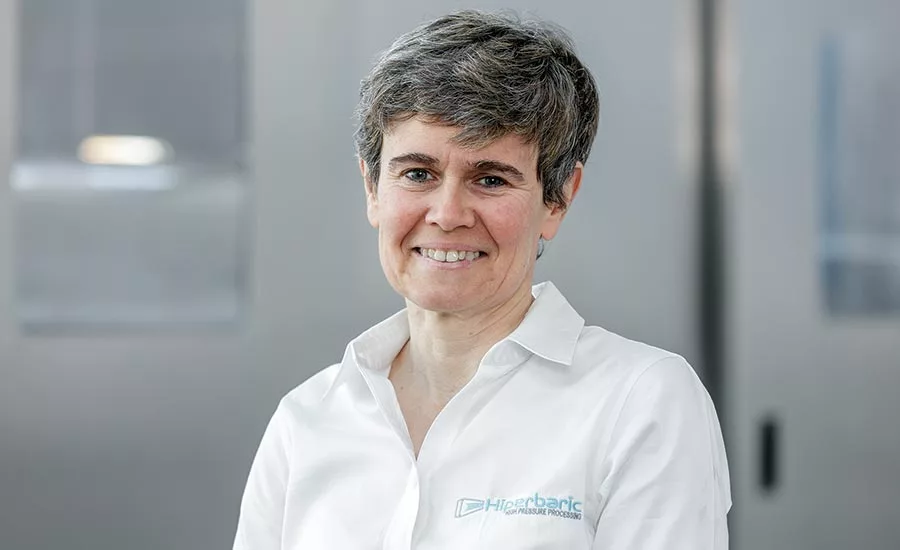Engineering R&D
Could the next big step in HPP be bulk processing?

Carole Tonello-Samson, applications director, Hiperbaric
Photo courtesy of Hiperbaric

Newly developed Hiperbaric bulk technology allows manufacturers to process beverages before bottling, handling up to 10,000 liters per hour.
Photo courtesy of Hiperbaric
High pressure processing has been covered in FE since 2003 (at least online) when researchers were still testing the process in 35-liter vessels. Today, HPP has come a long way, with systems able to process as little as a few liters in a single batch to more than 500 liters at a time. Hiperbaric recently released a new machine concept for processing liquid in bulk; it’s capable of processing up to 10,000 liters per hour when equipped with two processing chambers of 525-liter volume.
The Hiperbaric 525 Bulk and 1050 Bulk systems have one thing in common—Carole Tonello-Samson. She is the commercial and applications director for Hiperbaric with more than 25 years’ experience in HPP. She oversees the company’s global scientific and technological support for HPP users and leads the business development of Hiperbaric’s new in-bulk technology and new 525 and 1050 Bulk HPP machines. She holds a Ph.D. in food science on the effects of HPP on inactivation of microorganisms.
For her work in bringing this new technology to reality, Tonello-Samson was recognized by the Food Processing Suppliers Association (FPSA) with its Women’s Alliance Network Red Circle Honor award. The Innovation and Inspiration Honor recognizes a woman who brought game-changing innovation or an inspiring idea in the last 18 months to her company and/or industry.
The HPP in-bulk technology allows more juice to be processed with a variety of packaging options, regardless of the material, design or size. The first in-bulk machine has been purchased and is in use at an independent French juice and beverage co-manufacturer and bottler.
Tonello-Samson is a member of the Executive Committee of the Institute of Food Technology (IFT) and has served as a member-at-large, secretary and chair.
See more Engineering R&D columns!
FE: How many HPP machines has Hiperbaric sold worldwide?
Carole Tonello-Samson: To date, we have installed 290 HPP industrial machines in 45 countries across five continents, and currently have more than 60% market share. With our world headquarters in Spain and North American headquarters in Doral, Fla., we export more than 90% of our equipment to North America (our main market), as well as Europe, Asia and the Middle East.
FE: What is your role at Hiperbaric?
Tonello-Samson: As applications director, I am involved in new product design in collaboration with our R&D/engineering teams. Currently, we manage 20 R&D projects, mainly funded by Spain or the European community.
I also work in HPP science and food safety in collaboration with the Hiperbaric Applications Department. Globally, I oversee the company’s scientific and technological support for HPP customers and lead the business development of Hiperbaric’s new in-bulk technology.
FE: What are some of the highlights you’ve seen in the HPP industry over the years?
Tonello-Samson: Prior to 2002, food was processed in HPP vessels vertically, and not efficiently. In 2002, the first Hiperbaric horizontal HPP prototype was installed in Spain in which food was placed in its final packaging and introduced into the HPP vessel. This allowed for more food to be processed, resulting in cost savings and efficiencies.
Until recently, HPP was a post-packaging process, and only packaged food or beverages in bottles could be processed. But with Hiperbaric’s latest innovation, large volumes of beverages can be processed in bulk, before bottling, increasing productivity (up to 5,000 liters per hour with a Hiperbaric 525 Bulk machine) and enabling the use of any packaging material besides plastic.
By processing juice in bulk using HPP, companies can process twice as much product per batch, and bottle their juice in any format they choose, from cans to glass bottles, many of which are more economically friendly.
FE: What are some of the pain points users had with existing HPP batch equipment?
Tonello-Samson: The main challenges of HPP are price and production. The economics are more favorable with a bulk machine because the vessel has a 90% filling ratio compared to 45% on average for an in-pack machine. Since the in-bulk machine is fully automated, there is no manual handling of bottles or pouches, resulting in an 80% reduction in labor costs. The energy cost per liter of HPPed beverages is also cut by almost 50%, as almost twice the volume of juice is processed per cycle.
FE: What led you to push to develop the 525 and 1050 in-bulk machines?
Tonello-Samson: Large beverage processors are used to bottling/packing their products after heat pasteurization. Until now, HPP was difficult to implement because they could not easily substitute their current heat pasteurization process by in-pack HPP machines that process only bottled products. With the Hiperbaric Bulk, this challenge was solved. The HPPed beverage is sent to an ultraclean tank connected to the bottling line.
The Hiperbaric Bulk machine development was the result of a four-year R&D project granted by the European Union involving our engineering teams. The research project culminated in a demonstration day at the Fruselva Co. in Spain, where our first real-scale prototype was installed during the last part of the project in 2018. Last year, we sold our first industrial version of the Hiperbaric 525 Bulk to a copacker in France.
FE: How do the bulk machines work?
Tonello-Samson: They’re designed for low-viscosity products, such as beverages. The beverage is sent to an inlet tank, which contains a reusable and recyclable plastic pouch occupying 90% of the total vessel volume.
After that, the liquid is unloaded into an ESL (ultraclean Extended Shelf Life) tank and goes directly into an ESL filling line for bottling in any kind of packaging material.
FE: What are the design differences between the two models?
Tonello-Samson: Both machines share more than 80% of their components, including vessel, yoke and high pressure intensifiers. The Hiperbaric 525 in-pack or standard is equipped with a loading and unloading line for baskets carrying products. This model can process solid and liquid products.
The 525 Bulk can process only liquids (almost 500 liters per cycle). It has no loading and unloading line but works with a system of tanks and a large pouch inside the vessel. Its high pressure plugs are different than the ones of an in-pack machine. One of them can be cleaned and sterilized at each cycle, one of several patent-pending developments of this machine.
FE: Does bulk processing change the flavor or appearance of the juice?
Tonello-Samson: No, the flavor and appearance of the juice remain intact. We carefully load and unload the juice (pulp or not) into the vessel. This is done at very low pressure through a large diameter valve located in the high pressure plug, so viscosity, pulp aspect and flavor are not affected.
FE: Are the pressures and timing the same as for packaged products?
Tonello-Samson: Yes, exactly the same pressure and time. The process and product validations can be done easily whether the juice processed in-pack or in-bulk.
FE: Could this machine work with higher viscosity products?
Tonello-Samson: Not at this time. Guacamole or baby food, for instance, are too thick to be processed in-bulk at the current stage of the technology.
FE: You have a bulk machine at a customer site. How do they like it?
Tonello-Samson: Our customer in France, Ateliers Hermes Boissons, has reported favorable results. With the acquisition of the Hiperbaric 525 Bulk machine, they hope to meet the growing demand for premium juices in Europe.
To see the Hiperbaric 1050 in action, visit https://youtu.be/C765qAjg77o.
For more information, visit www.hiperbaric.com.
Looking for a reprint of this article?
From high-res PDFs to custom plaques, order your copy today!








